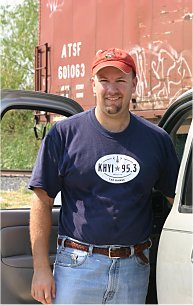Recent news articles motivated me to get the ball rolling on a project I've been thinking about for a while. Polaroid recently announced the unhappy news that it will soon cease manufacture of its remaining product lines of instant film.
New York Times article:
http://tinyurl.com/36zfwhColumbus Dispatch article:
http://tinyurl.com/yq4fol My tribute to the Polaroid: a sequence of images from Sunday's trip to Cleburne, digitally enhanced to make them "look" like Polaroids.
My tribute to the Polaroid: a sequence of images from Sunday's trip to Cleburne, digitally enhanced to make them "look" like Polaroids.Most of the younger generation has never experienced the magic of Polaroid photography, but anyone who's a "child of the '80s", or older, is probably familiar with them. Polaroid was instant photography in a world before digital; simply compose the shot, click the button, and "whirrr"... the camera would eject a small, square sheet of thick paper which would magically begin to self-develop. Within seconds, the image you just snapped would begin to appear like a ghost on the photo, very faint at first... but after a minute or two, it would be fully visible. (On the older cameras, you'd have to pull the photo out of the camera -- initiating the development process -- and then peel off and discard the emulsion layer. You'd be left with a nice print, approx. 3" x 4 " in size.)
Polaroid wasn't without its shortcomings: the square format was by no means suitable for every subject, the focus might be a little soft, and the exposure wouldn't always be dead-on... but for true "instant" photography, you couldn't beat it. I always enjoyed the compact and intimate nature of Polaroid photos. They were the ideal size and format for casual snapshots. The viewer would have to hold them up close to see them. And they were small enough that you could assemble a collage or a series of them to tell a story, and the finished project still would not be overwhelmingly large.
 "Virtual Polaroid" view of Barnhart, Texas
"Virtual Polaroid" view of Barnhart, Texas It's somewhat ironic that digital technology (which was essentially the death knell for Polaroid and countless other traditional film and camera products) allows us to re-create "virtual" Polaroid images for the sake of nostalgia. By re-sizing and cropping a digital photo to a square format and pasting it on top of a frame of a Polaroid background, it's easy to produce digital images that look for all the world like the real thing. Just don't expect it to be quite the same if you actually print one out.
Stay tuned for more; I'll probably be assembling more of these when the mood strikes. Until then...
WSC
np: Scott Miller & Commonwealth - "Dear Sarah"
Labels: Barnhart Texas, Cleburne Texas, photography, Polaroid, train photos
 There are few things M enjoys more than a display caboose. You think some wimpy little sign is gonna keep him off these things? Here he is, checking out an old Frisco waycar in Pauls Valley...
There are few things M enjoys more than a display caboose. You think some wimpy little sign is gonna keep him off these things? Here he is, checking out an old Frisco waycar in Pauls Valley... Santa Fe caboose in Purcell
Santa Fe caboose in Purcell "Slug-bug bug" near Lexington. If this was supposed to be a spider, it was missing a couple of legs...
"Slug-bug bug" near Lexington. If this was supposed to be a spider, it was missing a couple of legs... Built in 1904, the Santa Fe depot in Shawnee was designed to resemble a Scottish lighthouse. In our opinion, it looked more like a castle...
Built in 1904, the Santa Fe depot in Shawnee was designed to resemble a Scottish lighthouse. In our opinion, it looked more like a castle...
















































